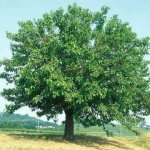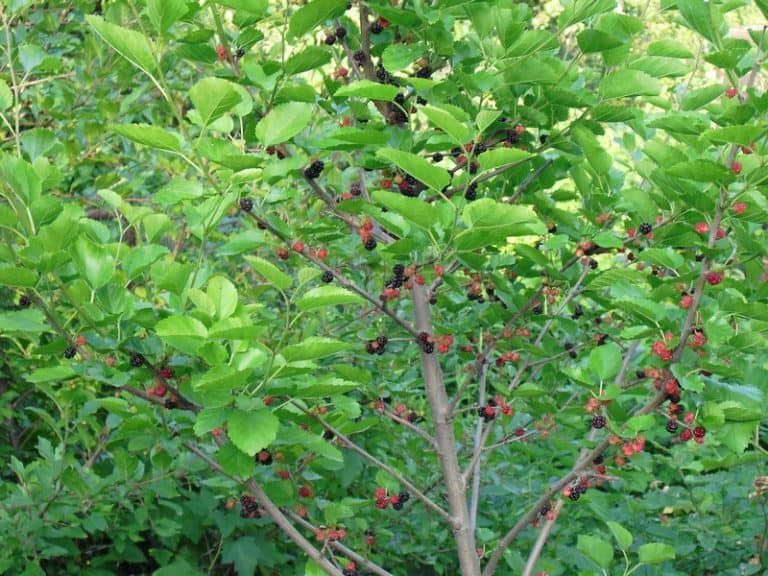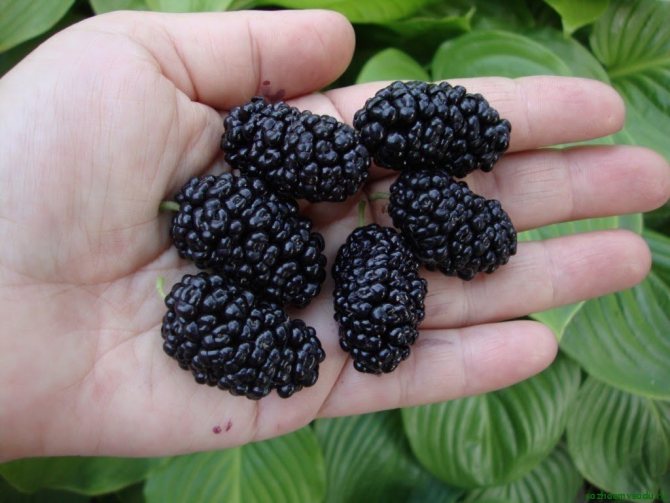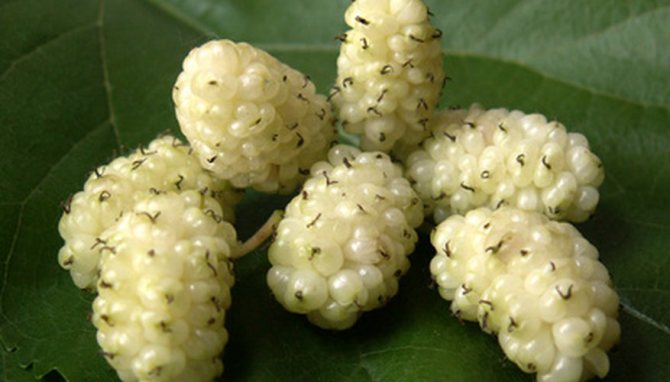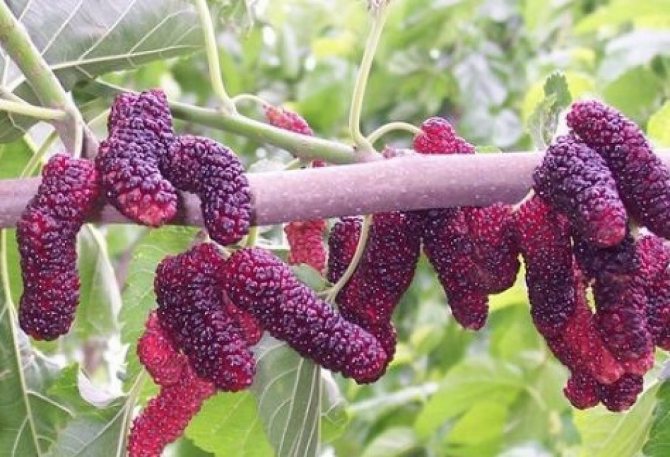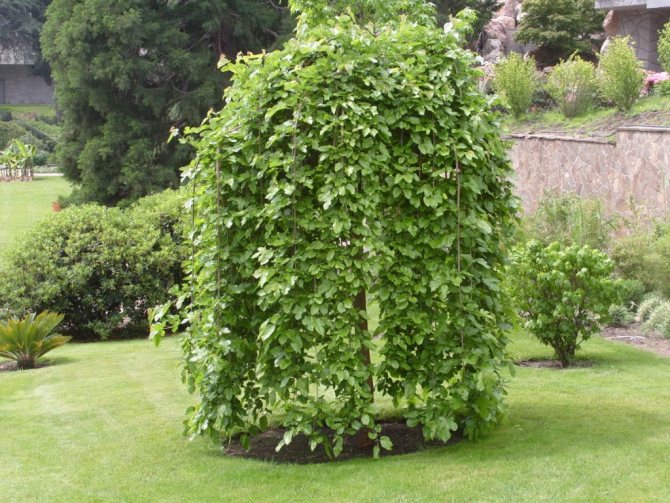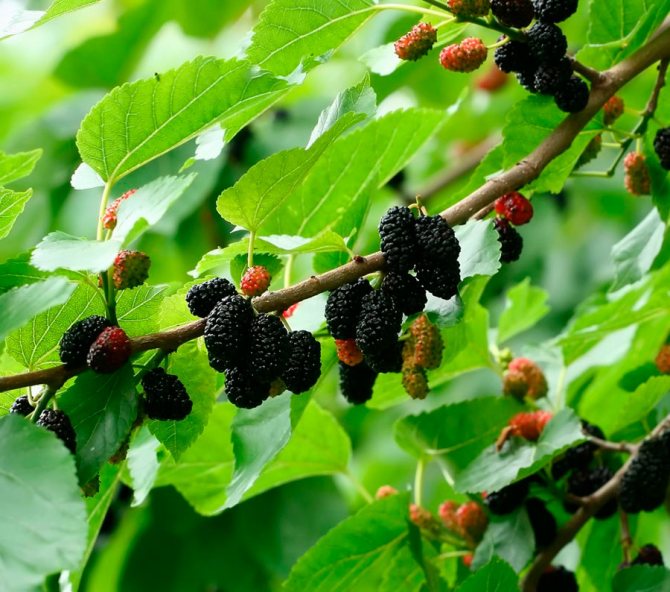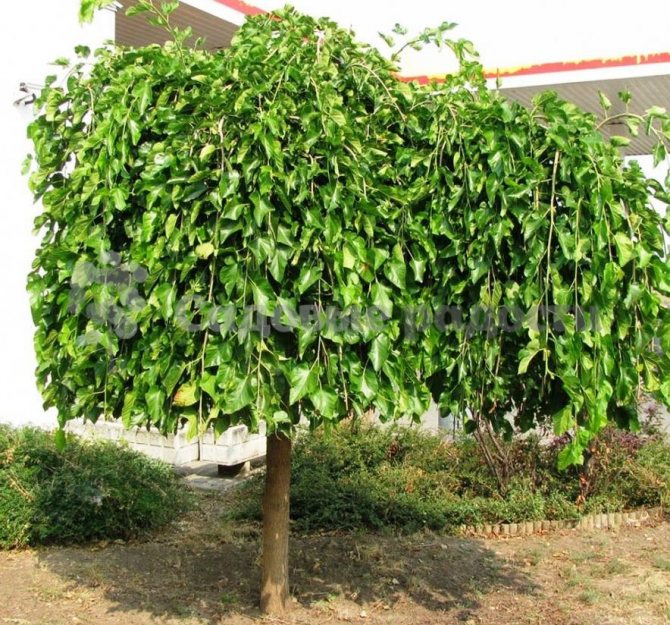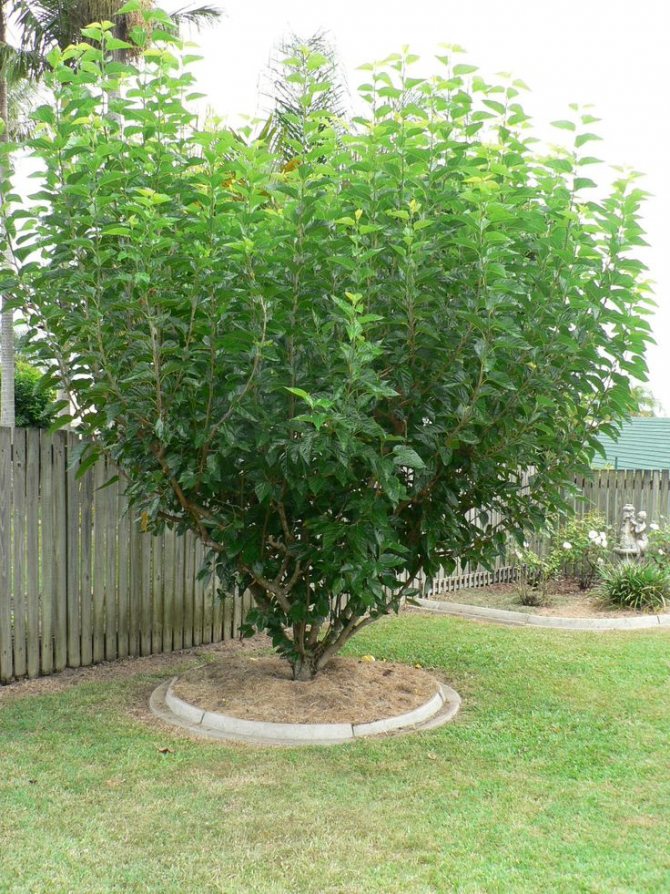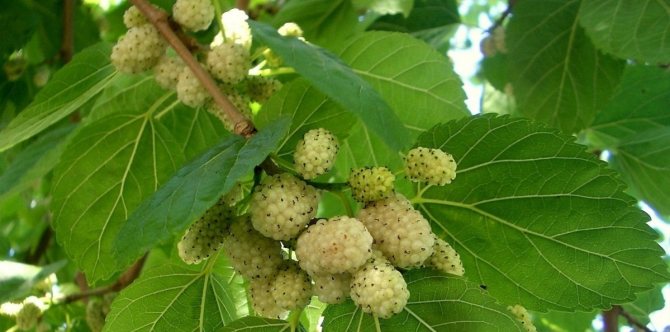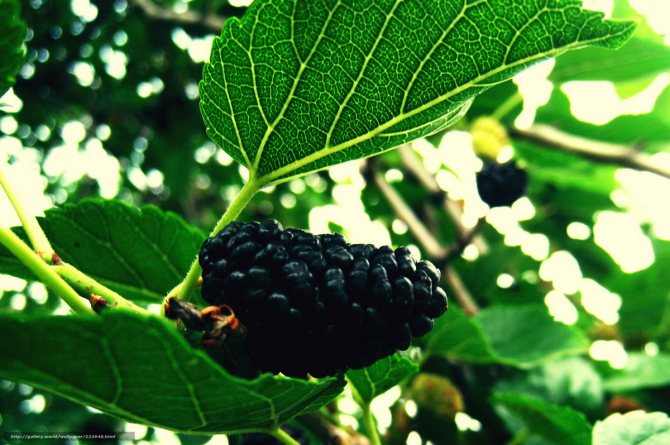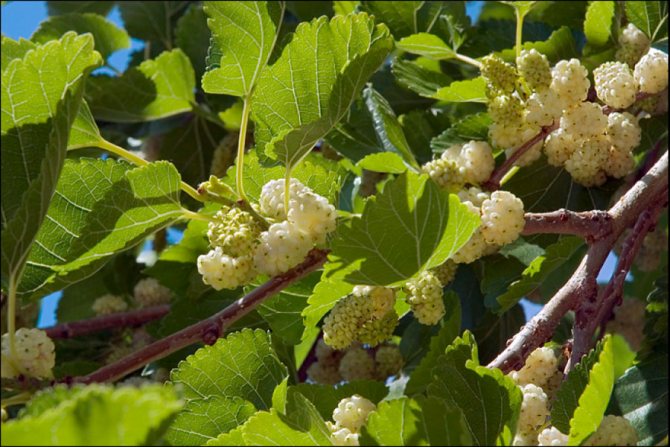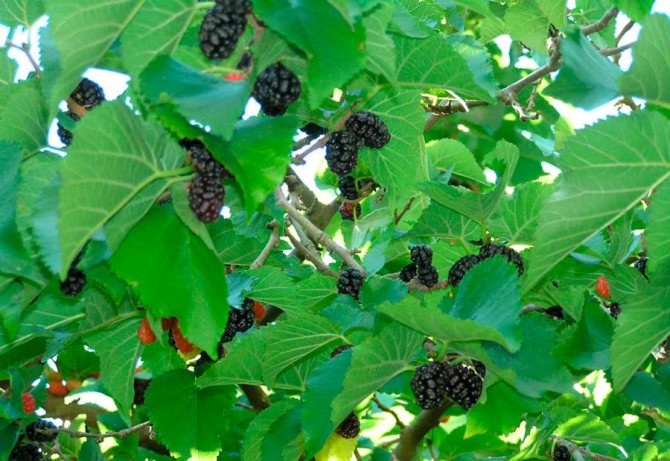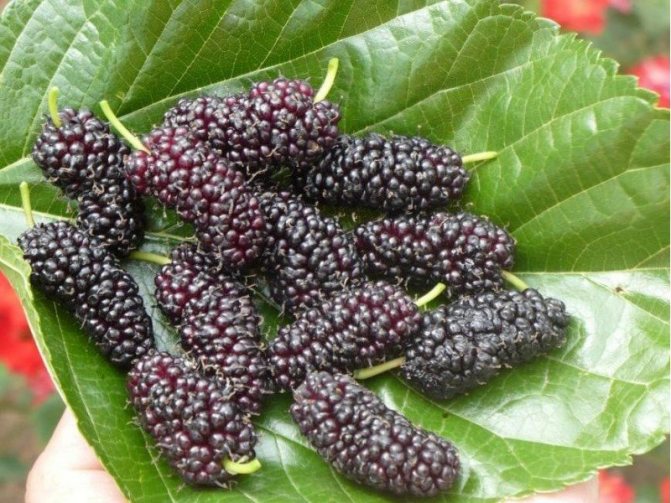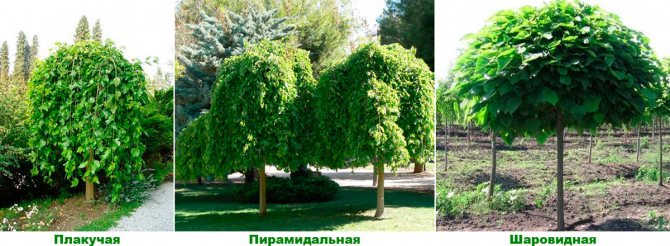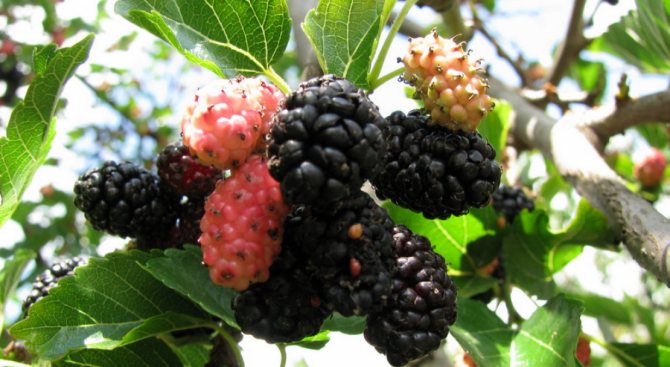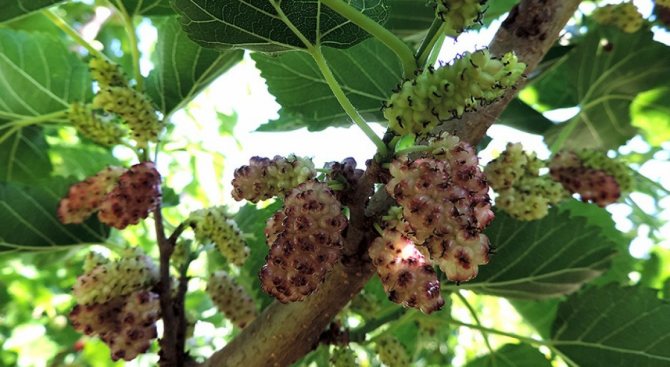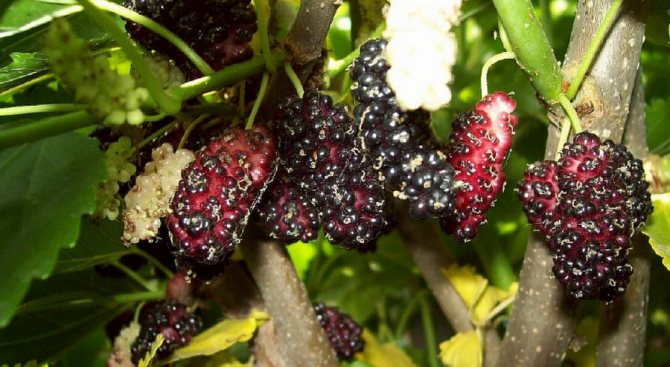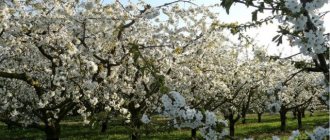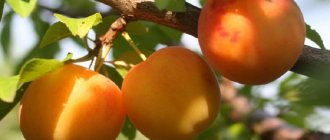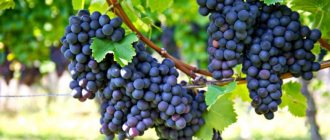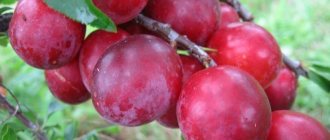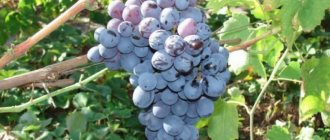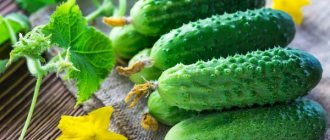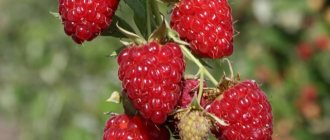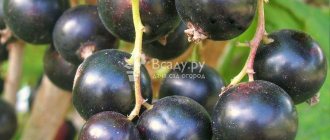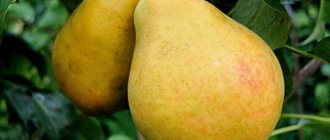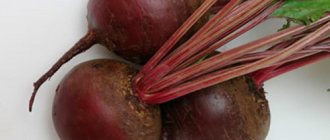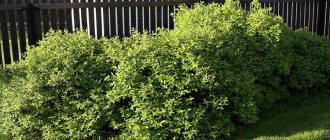Mulberry species
There are about 20 species of this culture, but for convenience it is customary to divide it into white, red and black, depending on the color of the bark.
White mulberry is most commonly found in Russian gardens. It is a tree up to 16-18 meters high with large leaves that are designed to feed the silkworm. Compound fruits of white, pink or purple color up to 3.5 cm in size. The plant is very resistant to low temperatures, can withstand frosts down to -30⁰С, therefore, white mulberry in the Moscow region is considered one of the best varieties for breeding.
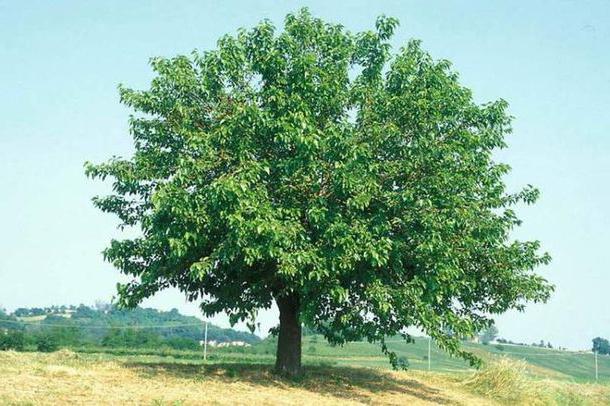
The wild red mulberry is found primarily in eastern North America. Its small, up to 3 cm, very aromatic stems can be red, purple or black. A sturdy tree that can withstand arid climates, it can grow up to 20 m in height.
Black mulberry grows in Southwest Asia, the height of the tree does not exceed 15 meters. Large seed fruits (up to 5 cm) of purple or black color are very juicy and tasty. The plant is not adapted to cold climatic conditions, it does not tolerate frost well.
Mulberry varieties
There are about 17 species of mulberry in nature. In Russia, two main types of it are grown - black and white mulberry. Consider the varieties of mulberry tree suitable for growing in the climate near Moscow:
- Vladimirskaya. The tree is up to 6 m high, the fruits are dark purple in color, 3 cm long. This mulberry can be used to form a shrub or tree that resembles a weeping willow. The variety is frost-resistant, there is no need for pollinators.
- Royal. The variety is famous for its large and sweet fruits that tolerate transportation well. A tree of medium height is characterized by increased productivity and frost resistance, no shelter for the winter is required, but pollinators are needed, planted nearby.
- Black Prince. The variety is famous for its large fruits, up to 5 cm long, frost resistance and unpretentiousness to the composition of the soil, it can do without watering, but pollinators are necessary.
- White Honey. Possesses sweet white fruits, resistance to cold weather, unpretentiousness to soil, high productivity. But there is also a significant drawback - a very short shelf life of fruits - 6 hours.
- Black Baroness. Differs in enlarged fruits of dark purple color, up to 4 cm long. The variety is characterized by high resistance to cold, increased productivity, among the shortcomings can be noted a short shelf life of fruits - 12 hours.
- Staromoskovskaya. The variety is distinguished by tall trees, up to 10 m, sweet blue-black fruits up to 3 cm long.
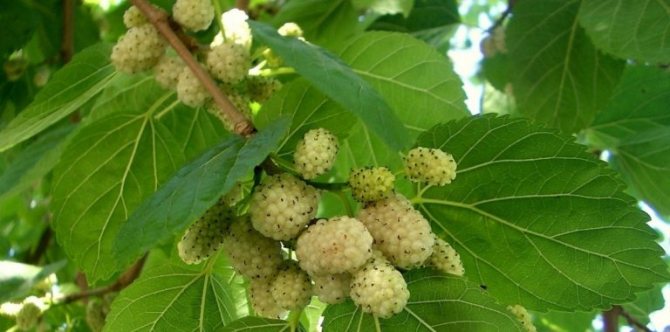

Mulberry varieties
Several varieties are considered the most suitable for the Moscow region. These are those that tolerate a long and frosty winter well, are not afraid of frost and are unpretentious to the soil. They all belong to the white mulberry species.
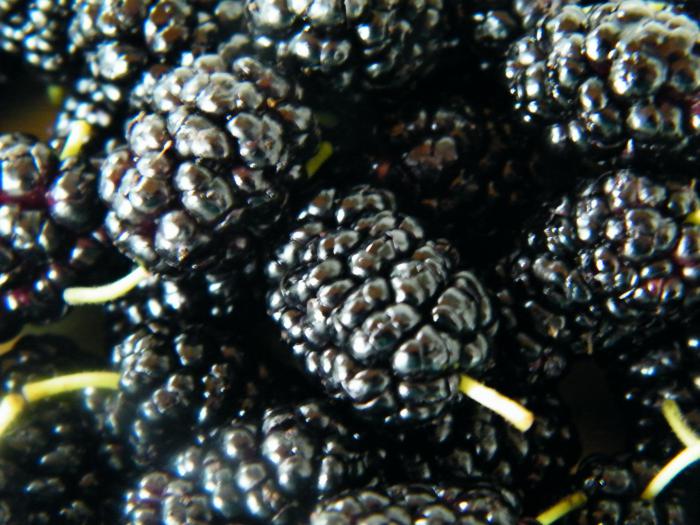

- Ukrainian-6. The tree has a spherical crown. The leaves are whole, very large, because they are intended for feeding the silkworm. Compound fruit of a black matte color can reach more than 4 cm in length. The yield of berries is low, but they are very well preserved.
- White honey. A monoecious tree with a pyramidal crown, very resistant to frost. It can withstand temperatures up to -30⁰С.Compound fruits up to 3 cm in size have a white color and a sweet honey taste. The aroma is practically absent. Ripening of berries occurs in June-July.
- Black Baroness. The variety is quite unpretentious in terms of keeping conditions, it can easily withstand very severe frosts. The crown of this tree is moderately dense, spherical in shape. Berries that are black in color, very sweet in taste, with a mild aroma.
Gardeners reviews
Evgeniy, 56 years old, Podolsk:
I have been growing mulberry trees in my garden for many years. I have the Black Prince variety. Caring for it is simple, we cut it under a bush, so it endures the winter easier. The yield is high, we even make wine. Berries help with heart disease.
Elena, 38 years old, Sergiev Posad:
Five years ago, a mulberry of the Black Baroness variety was planted in the garden. The berry is good for everyone, both large and sweet, only you need to eat it as soon as possible, it is not stored for a long time.
Nikolay, 65 years old, Orekhovo-Zuevo:
10 years ago I planted mulberry trees on the site. They began to bear fruit in the third year. The berries are black, sweet, the yield is good, only the birds flock, you have to put stuffed animals, and cover the trees with a net.
Reproduction
Mulberry cultivation in the Moscow region can be carried out in various ways - by seeds, sprouts, grafting, cuttings. Planting requires seeds from the current crop. Peeled from the pulp, they are sown in fertile soil in February. The temperature in the room should be maintained at 20 ° C. And after the warm days come, young plants are transplanted to the beds. Mulberries are transferred to their permanent habitat only for the next year. You should be aware that when propagated by seeds, some properties of the variety may not be fully inherited.
How to prune and propagate
Mulberry is a tall plant. Therefore, many gardeners try to shape and shape it in the form of a shrub in the early years. Mulberry pruning is done in early spring. It is necessary to carefully examine the plantings and remove all dry, as well as suspicious branches. During sanitary pruning, diseased branches are also removed, since it is in them that pests hibernate. Such branches are taken out of the garden and burned. A mulberry tree in the Moscow region should also be formed in the spring. The stem of the plant is made up to 2 m high. This procedure will protect the plants from severe frosts and make it easier for gardeners to care for the crop.
You can propagate a mulberry tree yourself by grafting. However, this should be done exclusively at the beginning of summer (from June to the first half of July). It is during this period of the year that the culture undergoes an intensive growth of shoots.
It is important to cut and fertilize the mulberry correctly.
For cuttings, only shoots of the current year are selected. The twigs are divided into several cuttings so that each has a length of 15-20 cm. It is desirable that each cut has 5-7 buds. The finished cuttings are kept in a root solution for several hours, and then planted in fertile soil. It is important that the cuttings are not planted in the sun; areas with a lacy shade are better suited. It is also worth paying attention to the fact that there are 2 leaves on each layer, but they need to be cut in half.
The cuttings are watered abundantly and make sure that the soil does not dry out. With good watering, by the fall, the layers form a developed root system.
Important! It is not recommended to replant them permanently in the fall, it is better to postpone this work until the spring and, with the arrival of warm weather, plant the cuttings in the necessary places on the site.
For the winter, young cuttings should be covered with straw or mulched with other materials.
If you follow the recommendations above, then there should be no problems with planting a crop. It grows well not only in the south of the country, mulberry will bear fruit every year even in the Moscow region, if the variety is selected correctly!
Planting and leaving
When choosing a site for planting, preference should be given to well-lit places with loose loamy or sandy soils, given that mulberries can live up to 300 years. In the Moscow region, seedlings begin to be planted in early spring or late autumn.
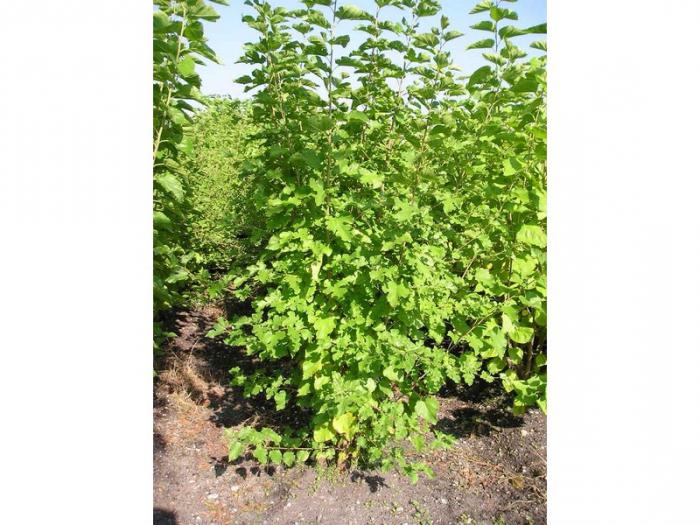

A pit measuring 80 x 80 x 60 cm is prepared in advance. Having sprinkled a little soil into it from the upper fertile layer, it is necessary to add two buckets of humus and 150 g of fertilizer. Mix all the components, place the plant in the center of the pit, gently spreading the roots, and sprinkle with soil mixture, lightly tamping. Then well water and mulch the soil around the seedling. During the period of intensive mulberry growth, it is necessary to feed in the form of diluted slurry (1: 5) or bird droppings (1:10). Since July, watering is carried out only in case of drought.
Mulberry planting
A favorable time for planting mulberries is spring or early autumn. The place is chosen well-lit, ideally - the southern slopes. Mulberry is undemanding to soil, can grow on saline soils, but prefers well-drained loams.
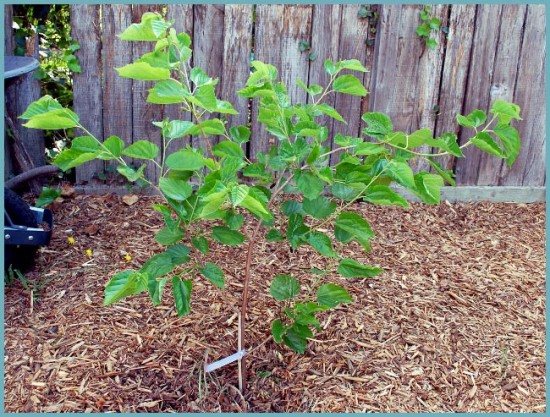

Choose a bright place protected from the winds for the seedling
Planting holes are prepared in advance so that the soil will stand. Size 70 x 70 cm and up to half a meter deep. The removed soil is mixed with a bucket of humus, half is placed in a hole, a seedling is placed on top, the roots are straightened and sprinkled with the remaining soil. They compact the earth around the stem and water it. Depending on the future formation of the seedling, the distance between the trees is set differently. 5 m is left between the standard forms, and 3 m between the bush forms.
After planting, the soil must be mulched - mulch will protect the plant roots from freezing in winter.
Advice. Mulberry is divided into male and female. It is better to purchase seedlings in the nursery that have already borne fruit once, so you will definitely get a fruiting tree. Males do not bear fruit and are used only for landscaping or decoration.
Wintering
Despite the fact that the mulberry adapts well to weather conditions and is able to withstand frosts down to -30⁰C, the plant often suffers from a lack of heat, and this leads to a decrease in yield. With the onset of spring, the frostbitten branches are cut off and during the summer period the plant is completely restored.
Mulberries can grow up to 20 meters or more under good conditions. In the suburbs, where winters are quite severe, it is necessary to prune the plant, giving it the shape of a bush so that it can be sheltered in the cold season with the onset of especially severe frosts. The crown is tied with burlap or paper bandages, fastened with twine, to a height of about 2 meters.
Pros and cons of mulberry Black Baroness
The advantages of this variety are obvious:
- high productivity;
- frost resistance;
- large fruits;
- adapts well to different climatic conditions;
- does not require additional pollination, since the tree is monoecious.
But there are some disadvantages of this variety:
- poor preservation and impossibility of transportation;
- requires a lot of light.
The plant is not capricious in care and maintenance, and when pruned, any decorative shape can be formed from it. The "weeping" type of mulberry is excellent, when long branches with a beautiful bend are able to reach the ground.
Mulberry use
In addition to industrial sericulture, this plant is widely used in various fields. The wood is used to make paper, rope and paint. The fruits are used for fresh and dried consumption, as well as for the preparation of various syrups, jams, vinegar. Almost all parts of this plant have medicinal properties.
Mulberries have anti-inflammatory, antiseptic, diuretic effects. Medicines based on the leaves are used for diabetes mellitus, vitamin deficiency.A decoction of the bark helps with cardiovascular diseases. For peptic ulcer, hypertension, throat diseases, mulberry is useful. In the Moscow region, it is quite easy to grow this tree if you follow all the recommendations for planting and caring for it.
In the southern regions of Russia, you can often find a beautiful spreading tree covered with berries - mulberry, or, as it is also called, mulberry. The multi-colored (black, red and white shades) berries taste good, there are always a lot of children around such trees. And adults often cannot pass by so as not to feast on these southern gifts of nature.
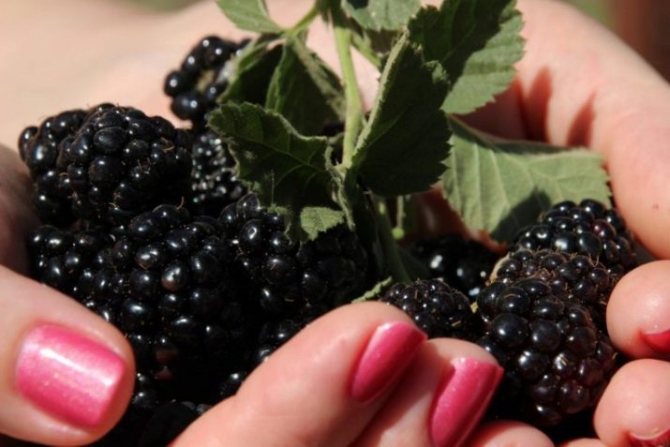

The plant reaches a height of 15 m, gives abundant harvests, has good wood, and its fruits contain many substances useful to the human body. It is not surprising that gardeners of the central and northern regions have long been interested in this southern plant, and the breeders were faced with the task of developing varieties adapted to the weather conditions of a cool climate.
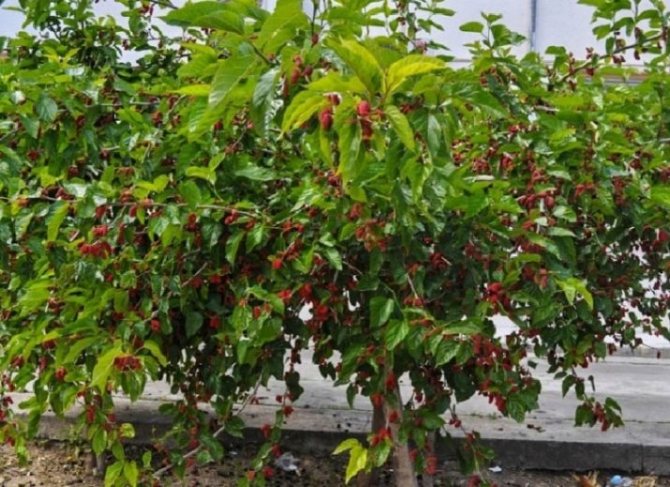

Mulberry benefits
As you know, silkworm caterpillars feed on mulberry leaves, with the help of which highly valuable natural silk is obtained. Mulberry wood is often used to make musical instruments.
Juices, compotes, jelly and wines are prepared from mulberry fruits. They are dried and added to confectionery.
Mulberries are widely used in folk medicine, their use improves the condition in many diseases:
- With diseases of the cardiovascular system, shortness of breath and heart pain decreases.
- Thanks to the presence of many vitamins and minerals, the activity of the thyroid gland improves.
- The fruits have a choleretic and diuretic effect, relieve inflammation.
- The fruits are used in the treatment of bronchitis, asthma, and improve the functioning of the intestines.
- Mulberry berry juice is used to heal wounds, for stomatitis and colds.
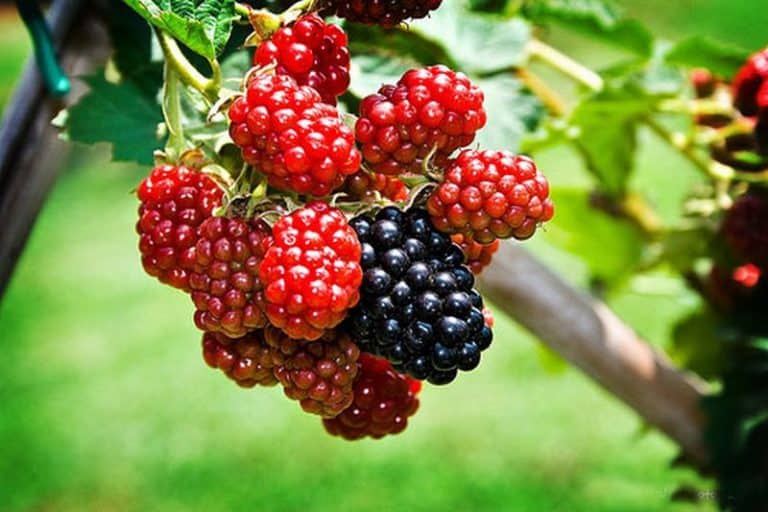

With caution, it is necessary to use mulberry fruits for hypertensive and diabetics.
Features of the
The varieties bred for the northern regions are adapted to long frosty winters, short summers and short daylight hours. They can withstand temperatures down to -30 degrees. However, this only applies to certain varieties, which will be discussed below.
Species bred for cold climates reach a height of no more than 3-4 meters. But this is quite enough to block the sun's rays, so they are planted away from gardens and windows.
A full crop of mulberry trees can be harvested as early as 3-4 years after planting. Mulberries are black, white or red berries. Interestingly, from a biological point of view, these blackberry-like berries are classified as nuts.
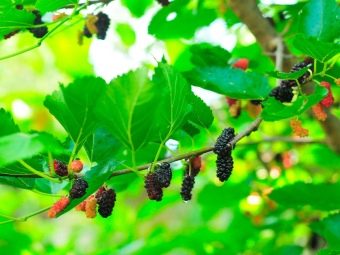

Description of the plant
The mulberry tree or mulberry belongs to the Mulberry family. It has a high growth rate at a young age, the tree reaches a height of 10-15 m. The mulberry has a powerful root system and a spreading crown. The leaves are alternate, heart-shaped with a sharp end and jagged edges.
The fruits are seedlings of fleshy achenes 2-3 cm long, outwardly resembling a blackberry berry. Fruits of sweet taste, they are white, red, bluish-black in color.
Flowering occurs in April-May, the fruits ripen in May-June. At the same time, the mulberry tree has unisexual flowers - staminate or pistillate.
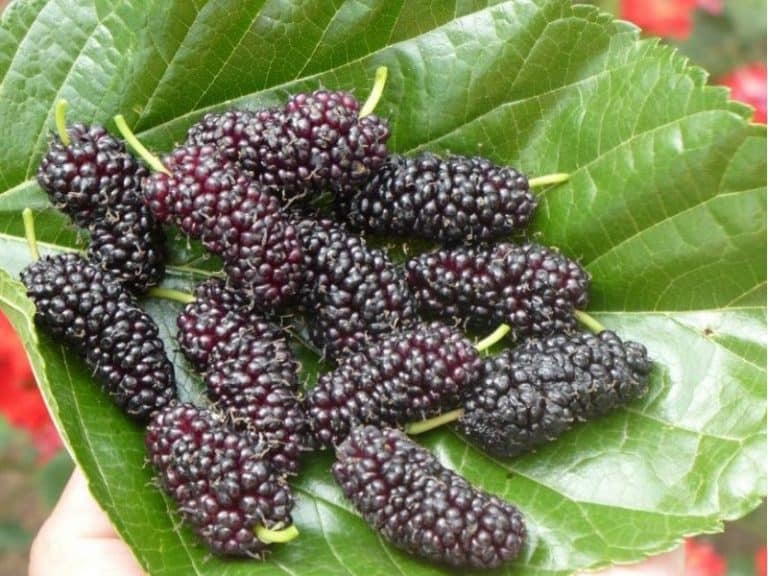

Fruiting begins in the third season of the tree's life, a full harvest ripens 5 years after planting. Mulberry is famous for its longevity - the tree usually lives up to 200 years.
In the Moscow region, mulberries are turned into a bush by pruning. This makes it easier to cover the plant for the winter. A mulberry tree can withstand frosts of at least -30 degrees under the condition of a snowy winter. Frostbite branches grow back, but freezing of the roots can lead to the death of the tree.
How to choose?
- When purchasing a seedling, it should be remembered that it is better to take a plant bred in the area where it will grow in the future. There is no point in bringing mulberry seedlings from the south - they will not be able to overwinter, let alone bear fruit.
- When buying, it is better to take a plant on which there are one or two berries to make sure that the seedling is not male. Only such a plant will yield good yields in the future.
- It is imperative to clarify whether this mulberry is self-pollinated. Otherwise, a pollinator will be required.
- The best option would be to purchase a mulberry tree in local nurseries, where there is confidence that the mulberry tree has undergone acclimatization, is not infected with tree diseases, will tolerate planting well, has frost resistance and self-fertility.
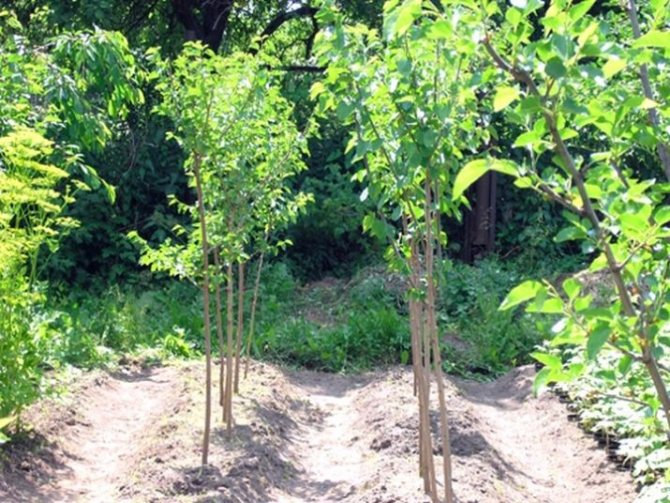

Harvesting
The yield of the mulberry Black Baroness is high. But these berries are not subject to storage, as well as long-term transportation. Therefore, it is recommended to harvest carefully. There is no need to climb a tree for berries. You just have to wait for ripening. The finished crop itself falls to the ground. It is enough just to lay a waterproof material or polyethylene and shake the tree slightly. All berries that are ripe by this time will fall. Those that will not be eaten during the first day are recommended to be recycled.
Suitable varieties
If there is an opportunity to get acquainted in detail with the features of the proposed varieties, then you should definitely use it. Mulberries are classified not by the color of the berries, but by the color of the bark, but for gardeners it will still be more convenient and practical to choose the berry shade.
It should not be misleading that in the northern regions, biologists advise growing white mulberry, as it is the most frost-resistant. It must be remembered that we are talking about the type of bark, not the color of the berries.
As for the berry shades, the varieties described below are suitable for the climate of the Moscow region.
- White. Ideal for growing in cooler regions. Here you can about and "White Honey". These are adapted species. Withstand low temperatures, unpretentious to soils. The berries are sweet, light beige, reaching a length of 4 cm. The varieties are characterized by abundant harvests throughout the season, the trees are self-pollinated.
- Red. These are "Vladimirskaya" (red fruits), "Smolensk pink". Tall trees, reaching a height of 5 m. The crown is spreading, with many shoots. Self-pollinating and frost-resistant. The berries are quite large - 3 cm.
- Black. The most hardy varieties are "Black Baroness", "Black Prince", "Ukrainian-6". Undemanding to soil, frost-resistant. Partially self-fertile, therefore it is recommended to plant them with other pollinating varieties.
Among the adapted varieties bred, there are many other names.
As already mentioned, the main thing is to choose seedlings grown in the area where the tree will grow.
Description Mulberry Black Baroness
Despite its name, the Black Baroness belongs to the white variety, as it has a light bark shade. This variety is related to early varieties of mulberry. The fruits ripen in June-July. Up to 100 kg of berries can be harvested from one tree.
The aroma of the berries of the Black Baroness is weak, and the taste is sweet. The plant is able to withstand frost down to -30 ° C, but only if it is short-lived. Therefore, the tree can be grown in Central Russia. Inflorescences with a light green tint, fluffy.
Reproduction
There are several ways to multiply mulberries.
- Seeds. This method is used by breeders to subsequently breed new varieties. Seed reproduction is long-term - it takes 2-2.5 years before planting in open ground.
- Cuttings. The method allows you to get a powerful root system, but it requires too much labor.
- Saplings. This is the most common type of reproduction in summer cottages and garden plots.The seedling grown in a local nursery has undergone acclimatization and has grown sufficiently. At this age of the plant, it is already possible to determine whether the tree will bear fruit in the future.
Most popular varieties
As for the classification, it is very confusing.
The Mulberry family includes 200 species of trees, and only a little more than 15 of them are generally recognized.
There are 2 main forms of mulberry - black and white, which are divided into varieties. Let's get acquainted with the most remarkable representatives of a large family.
White honey
One of the most famous varieties obtained by domestic breeders. Bred by crossing several types of white mulberry. The tree is short. The crown of the pyramidal shape is rather thick. Fruits are elongated white drupes up to 3 cm long. They attract with an extraordinary taste - sweet, with a honey flavor. Berries are soft and require extra care during transportation. The variety has a consistently good yield and withstands low temperatures.
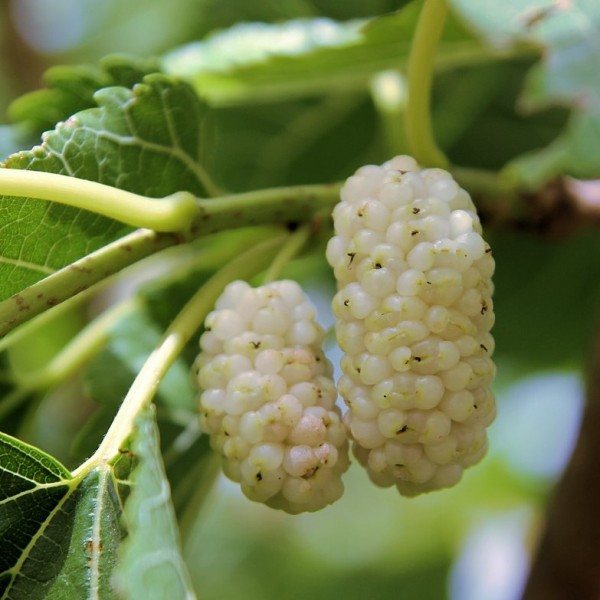

Smolensk pink
A great option for beginner gardeners.
The variety is easily adaptable to the environment and easy to care for. Differs in good frost resistance. Begins to bear fruit in the first year after planting.
Fruits are medium in size, pink or red in color. Fragrant and sweet. The beautiful shape of the leaves allows trees to be used as a spectacular decoration of the land.
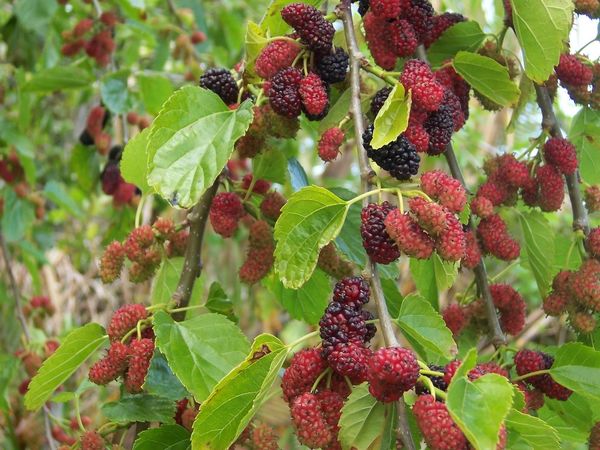

An early ripe variety that gives large and juicy fruits. Harvesting can begin in June. The main advantages are long-term fruiting and bright taste. The berries are sweet with a pleasant sourness. The mulberry tree is of a dense consistency; it does not wrinkle during transportation. A distinctive feature is that white seedlings turn pink in rainy weather. Do not be afraid - this is normal.
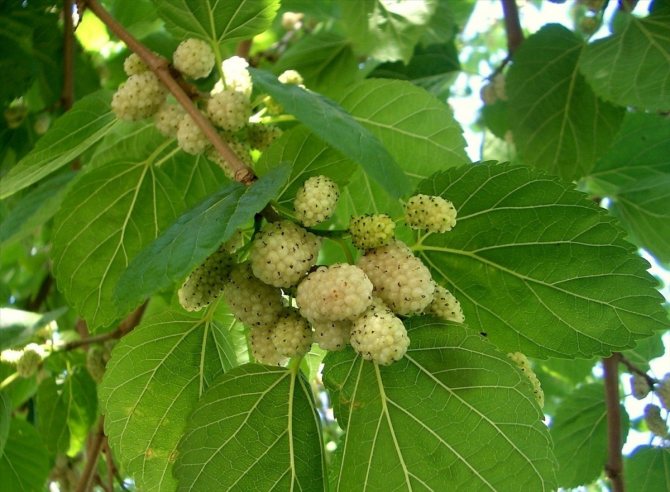

Merezhevo
If, when choosing a suitable variety for growing, your goal is taste, then pay attention to Merezhevo. The hybrid obtained as a result of grafting white mulberry has many undeniable advantages. Fruiting lasts 1 month. Fruits are large, attractive pinkish-cream color. The taste is sugary sweet. However, there were some drawbacks. The berries crumble quickly, do not tolerate transportation well and are stored for a short time.
Fruit-4
Good productivity is hidden behind the short growth and compact size of the tree. The fruiting period is long, the yield is good. Fruits are large (4 cm), color is black. The taste is sweet, with light refreshing notes. The variety is resistant to low temperatures and is excellent for commercial purposes. The mulberry tree does not lose its original characteristics during transportation.
Mulberry Black Baroness
The variety fully lives up to its original name. Obtained as a result of experiments of domestic breeders. Fruits are large (4 cm), deep black. Fragrant and very sweet. Ripen in July. Stored - 12 hours. Yield indicators are also at the "height" - one tree gives up to 100 kg. The Black Baroness easily tolerates temperatures as low as -30 degrees. Adapts to any environment if necessary.
Read also: Tomato - Volovye Heart: characteristics and description of the variety, reviews, photos
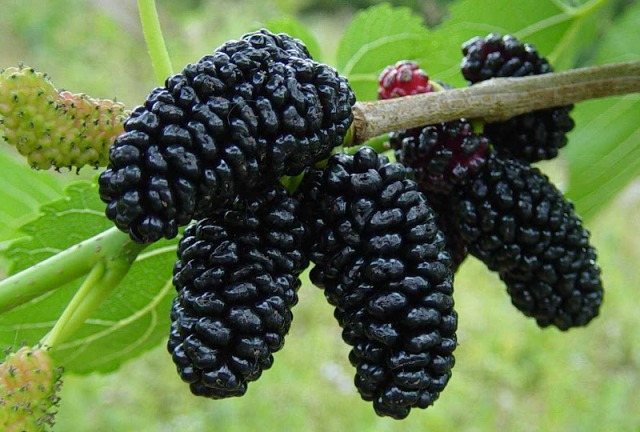

A variety familiar to many gardeners. It is characterized by high decorative effect. Produces large fruits (5.5 cm). Begins to bear fruit at the end of June. The berries are long, dark, with a characteristic shine. The taste is dessert.
The dense consistency makes it possible to transport large quantities without loss.
Those who want to grow mulberry trees for the purpose of resale should choose this particular variety.
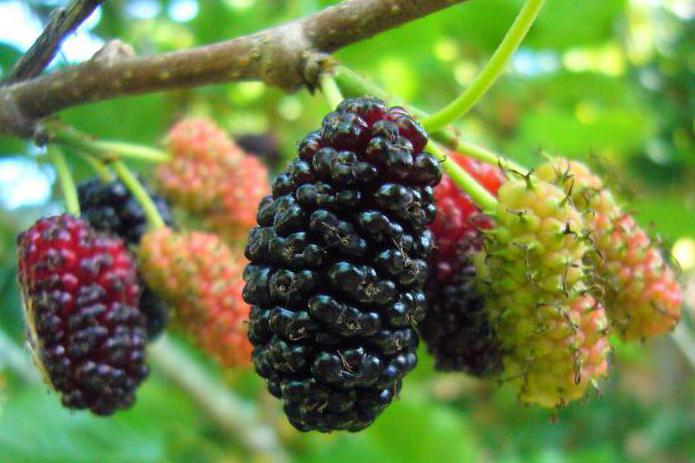

Black Prince
Another priceless piece. It seems to be made up of only merits. Easy to care for, resistant to drought, frost and disease. It is appreciated for the beauty of large and glossy berries, reaching a length of 5 cm. Color - black. The taste is unusual, honey.It is noteworthy that the mulberry tree is juicy, but at the same time it does not wrinkle during transportation and is stored for a long time.
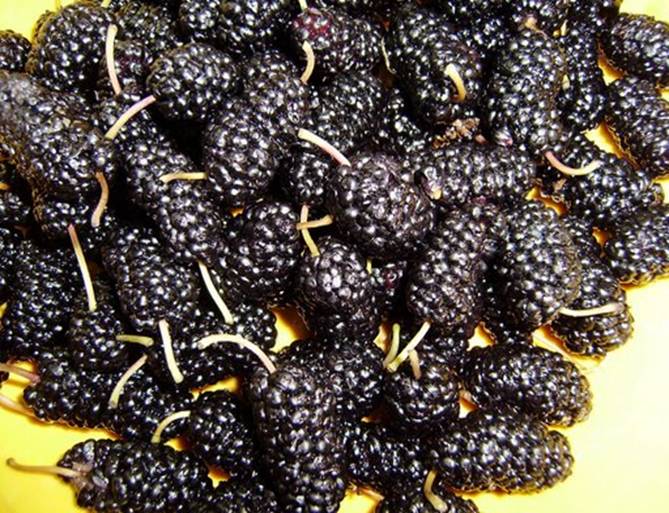

Fans of mulberry wine should plant this variety in their country house. Begins to bear fruit in the 3rd year of life. Yields are high and stable. The berries are large (5.5 cm), black. The thick juice obtained from them tastes like Cahors. The variety is actively used in winemaking and cooking. Easy to grow and disease resistant.
Ukrainian-6
It is appreciated for its high decorativeness and excellent taste. Fruiting begins in June. Fruits are elongated, large (4 cm). Color - matte black. The taste is sweet. The tree tolerates frosts down to -30 degrees without consequences. During transportation, the berries do not lose their original appearance. Stored - more than 2 weeks.
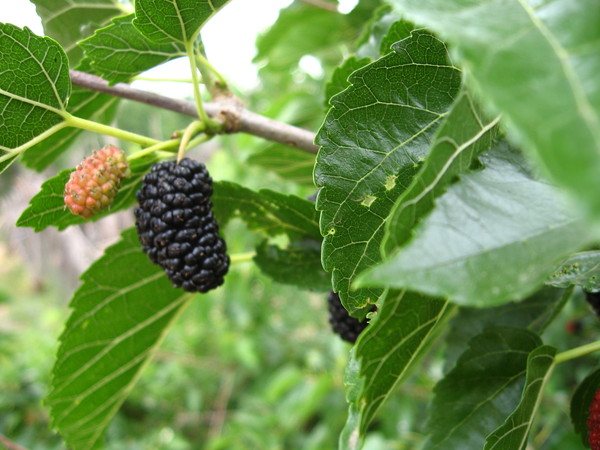

Above are the varieties intended for human consumption. However, there are many decorative varieties designed to embellish the environment. These include weeping mulberry, golden, pyramidal, Tatar, spherical. There are varieties that can be grown in small containers or pots. That is, the choice of a variety will directly depend on what goals you are pursuing.
Seat selection
As with planting any culture, first of all you need to decide on a place on the site. We must not forget that the tree will grow large and spreading. Even undersized varieties will block the light from smaller plants.
The best option for planting would be the sunny south side of the site, near the blank wall of a house or building. So the tree will receive the maximum amount of light, and the walls will block it from winter winds and snowstorms.
Many varieties of mulberry are unpretentious to soils, but they adapt best to loams. In sandy eroded soils under the root system, it is recommended to lay out drainage from small stones, gravel, broken brick. When planting, mineral fertilizers are added to any soil.
The mulberry tree is native to the south, therefore it tolerates drought well, but swampy soils are destructive for it. The same applies to the lowlands, where rainwater accumulates, spring floods pass.
The distance between planting trees or from high fences (walls, fences) should be at least 3 meters if the tree is bushy. The high die shape requires up to 5 free meters.
Do not forget that the tree will actively grow and develop, so it needs space, access to light and nutrients.
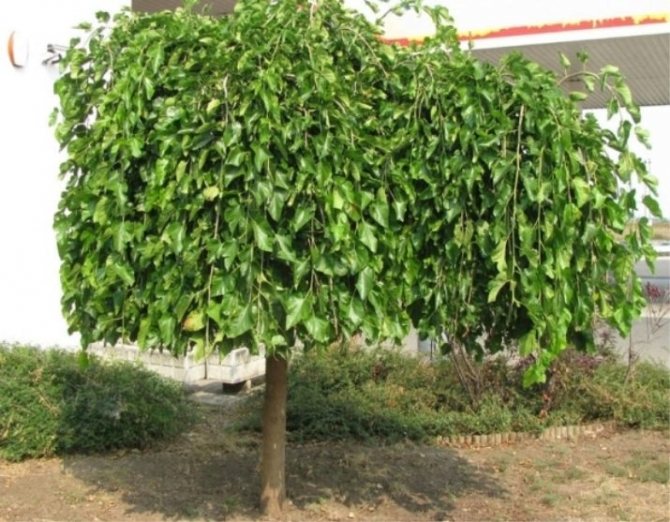

Preparing for landing
It is recommended to plant a mulberry tree in the Moscow region in the spring, before the juices begin to move. The selected area must be cleared of weeds and dug up with the addition of minerals and organics. Pits for planting 80 * 80 * 80 cm in size are dug in the fall. Peat is added to heavy soils.
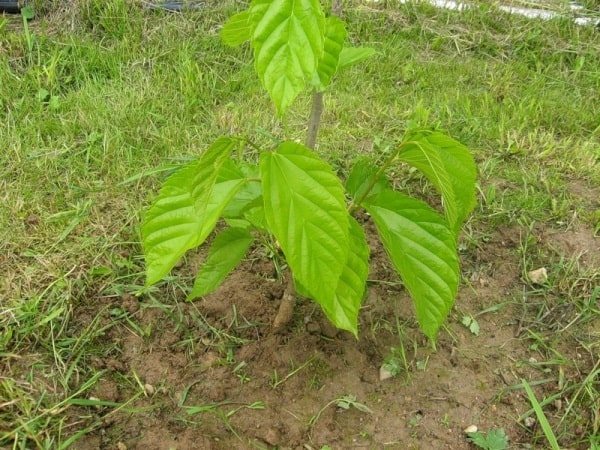

Seedlings choose three-year-olds that have already borne fruit, since it is impossible to determine the sex of the plant before fruiting. Fruits are formed on female trees, male trees are planted side by side for pollination and for gardening. It is advisable to purchase seedlings with a closed root system, without signs of disease.
Landing
For seedlings in the climate near Moscow, the most favorable planting period is spring. The plant will have a warm season ahead in order to root well and painlessly endure the next winter. It is necessary to plant the plant in April in order to be in time before the start of sap flow.
If necessary, it can be planted in the fall, long before the start of frost. But in this case, the tree will not have time to properly overgrow with bark. Autumn planting involves further covering the seedling with insulation material.
Landing is done in several stages.
- Preparation of the pit. A hole is dug up to half a meter deep, about a meter in diameter. The pit is allowed to stand for several days.
- On the day of planting, several layers of pre-prepared material are laid out at the bottom of the pit, which will provide the plant with rapid rooting.
- The first layer is covered with: drainage, if the soil is too light and prone to erosion; peat if the soils are heavy; compost or humus at the rate of 1 bucket per 1 pit.
- The soil obtained during the excavation of the pit is mixed with mineral granular fertilizers. One handful is enough to plant one tree.
An excess of mineral fertilizers is undesirable, since the plant can give a lot of growth.
- A seedling is lowered into the pit, carefully spreading and spreading the roots so that they lie freely. Sprinkle with soil just above the root collar. This will provide better frost survival.
- Having tamped the soil well, the seedling is fixed in an upright position with a peg. Mulch the soil around the plant with sawdust or needles.
If the planting was in spring, fertilizers are applied under a young tree in the first half of summer, systematic watering is provided. From mid-July, feeding is stopped, and the frequency of watering is reduced to a minimum so that the earth does not dry out in a hot summer. In the first season, the young plant also needs weeding and loosening to provide oxygen access to the roots and prevent the weeds from depriving the still weak bush of light and nutrients.
Preparing for winter
In autumn, the trunk circle is mulched with sawdust, foliage, needles or straw. The side branches are gently pressed to the ground and covered with insulating material. Autumn warming is carried out for seedlings planted before winter.
In the spring, the covering material is removed from the plant, the old mulch is removed, the soil is loosened, providing an influx of oxygen. Frozen shoots are cut off - new branches will quickly appear in their place.
Preparing for winter also includes fertilizing a mature plant. Autumn feeding will benefit the roots, and thanks to the upcoming winter season, the plant will not throw out new shoots. For feeding, use a weak solution of manure, ash, nitrogen and potassium.


Crown formation
The mulberry tree develops intensively in the first few years, gaining a branchy mass and trunk height, depending on the type of plant. Having hibernated 2 seasons, the tree is considered an adult, it is no longer afraid of further winters. In the third or fourth year, the mulberry will begin to bear fruit and will continue to grow.
The formation of the crown, of course, depends on the preferences of the gardener, but for the plant itself and for the aesthetics of the summer cottage, it is advisable to care for the mulberry tree by cutting off excess branches. In the spring, a mandatory anti-aging pruning is carried out. Frozen dry or blackened twigs are removed. April - early May is considered a suitable period for pruning, while the plant is not yet fully awake.
In bushy species of mulberry, branches are thinned and shortened, in standard species, overgrown shoots are removed, leaving the trunk and forming a crown at your discretion. The height and decorative formation of the crown depends on the preferences of the gardener; it can be made in any shape. So, in household plots where tall plants are undesirable, the crown of the mulberry is pinched at a height of two meters or the upper shoots are cut off.
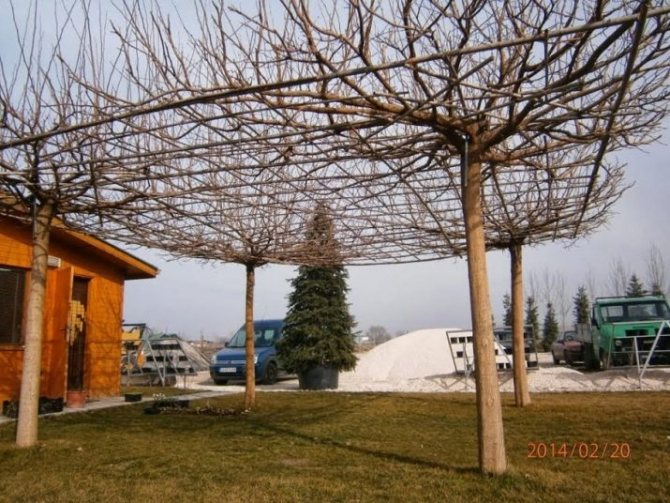

You can find important tips for planting and caring for mulberries in the following video.
Caring for a newly planted seedling
The fertilizers introduced during planting will be enough for the plant for 3 years; additional fertilizing at this time is not necessary. In the future, in the spring, the tree is fertilized with nitrogen and organic matter in mid-June. Watering is carried out as needed, the soil is not waterlogged and does not allow it to dry out too much in the heat. A mature tree does well without watering.
Young seedlings need protection from frost, trunk circles are mulched with spruce branches or foliage, side branches are slightly bent to the ground and cover the tree with spunbond. The edges of the fabric are fixed with stones.
Pruning and shaping the crown
The first few years, before the beginning of fruiting, the mulberry tree develops very quickly. Therefore, the main molding (tree or bush) is carried out at a young age. It is easier to cover the bush form for the winter, when pruning, the top is shortened, and the lower shoots are not touched, only dried up or not overwintered are removed. When creating a tree-like shape, the main trunk and several side branches are left, the rest are removed.
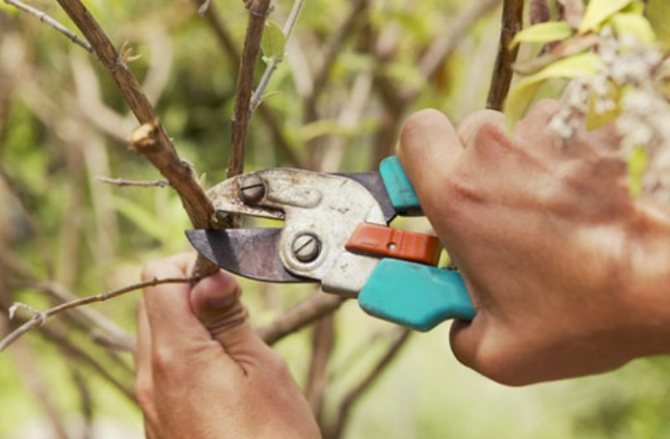

The main pruning is carried out in the fall, and preventive in the spring, in March or April. Once every 4 years, the crown is thinned out and corrected, too long shoots are shortened. In an adult tree (6 years old), all old branches die off by themselves, but it is better not to wait for this moment. In summer cottages, trees are usually formed no higher than 1, 5 or 2 meters.
Pest control
Mulberry is less susceptible to fungi, viruses and pests, especially when grown in cool regions, where the plant suffers more from frost. In the Moscow region, leaf spot is a danger; you can fight the fungus with any copper-containing preparation. Processing is carried out in dry weather in the morning or evening. Mulberry is attractive to birds; scarecrows will help drive away starlings and sparrows.
Diseases and pests
The causes of diseases of fruit plants are varied and depend on many factors. Faced with a similar problem, it is necessary to study the appearance of the damaged area and refer to a detailed description of treatment and prevention. Of the most common fungal diseases of the mulberry tree, several can be distinguished.
- Brown spotting. This fungal disease is characterized by spots on the leaves of the corresponding color. For treatment, a lime broth with the addition of sulfur is used.
- Powdery mildew. Light fungal bloom appears first on the leaves, and then spreads to the entire branch and berries. The tree must be sprayed with a lime-sulfur solution. It is advisable to carry out prophylaxis in spring and autumn.
- Tinder. The spores of the fungus multiply on the bark of the tree, turning it into dust over time. Under the bark, the fungus penetrates through open damage to the trunk. The damaged area of the bark is cut off and burned, and the "wound" is treated with a solution of copper sulfate.
Insect pests also contribute to mulberry diseases. There are three common satellites of the mulberry tree.
- White butterfly. Lays a huge number of eggs, which later become caterpillars. Caterpillars devour foliage and entangle shoots with dense cobwebs. To combat, a mechanical method is used (pruning spider nests) and a chemical method (spraying with chlorophos).
- Mulberry moth. The abundance of caterpillars on a tree can destroy the entire crop before it appears. For prevention and treatment, the same methods are used as with the white butterfly.
- Spider mite. A thin web appears on the lower part of the leaves, which subsequently leads to darkening of the foliage and premature fall. The diseased plant is sprayed with thiophos solution.
Mulberry, or mulberry, is a popular plant that is most often found in southern Russia. Its dark or white fruits (outwardly very similar to blackberries) are valued by gardeners for their excellent taste and a huge amount of nutrients. Experts cannot accurately name the homeland of the mulberry. In the wild, it is found in different parts of the world - in South and North America, in southern Europe, in East Asia. In Russia, it is best to cultivate this garden culture in the territory of the Southern Federal District. At the same time, good harvests can be obtained much further north. For example, recently mulberries have been successfully grown in the Moscow region.
An adult mulberry tree is a tall and powerful tree. Its height can vary, but usually at least 3-4 m. Some can grow up to 15 m in height. That is why it is advisable to plant seedlings of this garden culture away from other less tall plants.Otherwise, the rest in the garden will experience discomfort due to the proximity to the mulberry tree (they will not have enough sun, water and nutrients). The fruits of this plant are small: on average, their length is up to 3 cm. In the climatic conditions of the Moscow region, it is recommended to grow varieties of the white mulberry. The main advantage of this type of mulberry tree is its good winter hardiness. But trees with red and black fruits are best planted only in the south of Russia, as they suffer from cold and harsh winters, but at the same time they are drought-resistant.
UNIQUE AND HEALING
Modern "northern" mulberry varieties reach no more than 3.5 m in height. They perfectly tolerate winter frosts up to 35 °. But since the roots of this plant are superficial, with the onset of a "black" snowless winter, they can freeze out even at minus 15 °. To prevent this from happening, the trunks must be covered with fallen leaves with a layer of 30 cm and on top - with one layer of spruce branches.
But the frost resistance of the tree itself is very high, so in winter, in severe frosts, even the skeletal branches of the mulberry do not freeze.
Mulberries are somewhat reminiscent of juicy blackberries or raspberries. In the newest varieties, they are very large (up to 8 cm in length) and sweet, with a pleasant delicate aroma. In color, they can be creamy white, burgundy and dark purple. Ripen in late July - early August. Due to their delicate skin, they practically do not tolerate transportation, so they must be consumed fresh immediately or started to cook something from them (wine, juices, jam, compotes). Fruiting of young trees begins in the 4th-5th year.
Mulberry is quite unpretentious and can grow on not very fertile soils. In addition, it has increased drought resistance. The fact is that the tree has a powerful root system that penetrates deep into the soil and can safely take water and nutrients from there.
Mulberry can grow well and bear fruit perfectly in one place for more than 250 years.
Mulberry fruits are very healing. They contain a large amount of vitamins and nutrients, including such a rare element as morin, which is not found in any plant. Its wood belongs to valuable species and is equated with red and black trees, from which rare furniture is made, figurines are carved, decorative panels for wall panels in very expensive cottages and offices are made.
All parts of the plant are considered medicinal and are widely used in medicine for the preparation of various herbal teas and infusions.
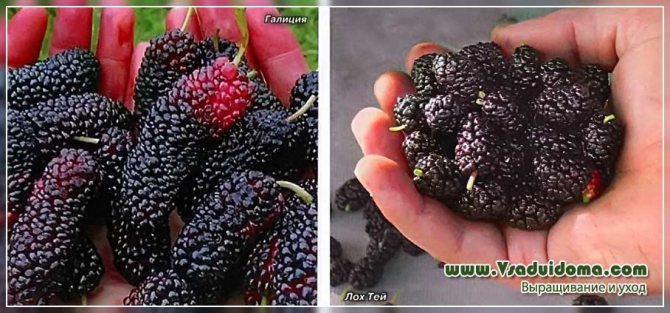

Mulberry in the Moscow region: growing and care
The cultivation of mulberry trees in the capital region has its own characteristics. The climate of the Moscow region is far from favorable for this southern plant. Before breeding, it is first of all important to choose a variety that will not only grow well, but also give a generous harvest in the Moscow region.
Important! When choosing a mulberry variety for growing in the Moscow region and the Middle Lane, you should pay attention to its winter hardiness. The varieties must necessarily withstand frosts down to -30 ° C.
Mulberry in the suburbs
Recently, breeders have developed several varieties of mulberry, well adapted for cultivation in the Moscow region.
- Vladimirskaya mulberry (red) has proven itself well. This is a tall and powerful tree that can grow up to 6 m. The crown of the plant is wide, giving many lateral shoots. The fruits of this variety are very sweet and aromatic, they have a dark purple color. The berries themselves are not very large, up to 3 cm in length. The main advantages of the variety are good winter hardiness and self-pollination.
- Another good variety for the Moscow region is the Black Baroness mulberry. The description of the variety says that the trees have an interesting and beautiful shape in the form of a ball. It grows well on any soil, even the poor.However, for a larger yield, it is still recommended to fertilize the soil before planting, fill it with compost and mineral fertilizers. The fruits of the variety are larger - up to 4 cm in length. They are juicy, black. But they quickly deteriorate (it is recommended to store them no more than 12 hours). The main disadvantage of the variety is that the fruits cannot be transported over long distances. In addition, the Black Baroness cannot boast of good self-pollination, the variety is partly self-fertile. That is why, for a rich harvest, it is recommended to plant other pollinating varieties nearby. At the same time, this type of mulberry tree also has a huge advantage for cultivation in the Moscow region - it has a high degree of frost resistance.
- Mulberry Smuglyanka in the suburbs also grows well. It is frost-resistant and adapted to the local climate. But the mulberry variety belongs to the white-fruited varieties. Primarily appreciated for good self-pollination. The trees are very tall and spreading. The berries themselves in the variety are not small - up to 4 cm in length. Fruiting constantly, without interruption. Yields are also abundant. It does not need additional pollinating varieties.
In addition, in the climate of the Moscow region, mulberries of the Ostryakovskaya variety, as well as White honey, Black Prince and Ukrainian, yield good yields. All of them withstand low temperatures in winter, high-yielding and are completely undemanding to soils.
Is it possible to grow mulberries in a summer cottage in the suburbs?
Mulberry in Russia is actively cultivated in the southern regions; it was considered exotic for cool regions. To the great delight of gardeners, it was a long time ago. Thanks to the painstaking work of breeders, the mulberry tree becomes a familiar plant for the risky farming zone.
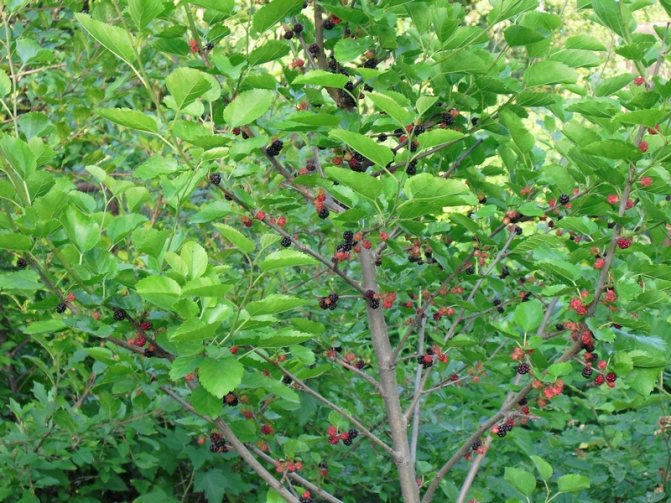

In the south, the tree tolerates frosts up to 35 degrees, but in areas with snowless winters there is a high risk of freezing of the root system, cooling the soil to 7 or 10 degrees is destructive. Another problem is the short daylight hours, in such conditions the mulberry divides the usual prolonged fruiting period into 2 separate ones. Due to this phenomenon, most heat-loving crops do not have time to fully prepare for winter.
Some varieties of mulberry can easily cope with the problem, they are able to withstand sudden temperature changes, and do not suffer from the rapid onset of frost. Young branches rarely freeze. The culture has an interesting feature - cork tissues are formed between the matured and immature branches, they allow the tree to independently get rid of non-viable parts of the shoots.
Mulberry in the Moscow region: when and how to plant
Many garden crops in Moscow are best planted in spring, and mulberry is no exception. Planting in spring allows the young plant to take root and adapt to local weather conditions over the summer. In the Moscow region, mulberry seedlings are planted in late April - early May, depending on the air temperature.
Important! It is undesirable to plant mulberries in the fall in the Moscow region. The seedlings will not have time to take root, as a result, thermophilic plants run the risk of freezing with the onset of cold weather.
The mulberry tree is a powerful and tall plant, so you need to choose a sufficiently large and well-lit area in the garden for it. This horticultural crop is not very demanding on the soil, but it should not be planted on swampy ground. She also does not like groundwater located near the soil surface. Slopes or small hills are best suited for mulberries. It should be remembered that they must be southern.
Note! Mulberry grows and bears fruit best of all on sandy loam or loamy soils. But do not despair if the soil on the site is slightly saline. In this case, you need to add a certain amount of fertile land, mineral fertilizers and drainage, since it is the long stagnation of water that badly affects the plants.
A pit for planting mulberry seedlings should be prepared in advance. For spring planting, it is better to make a hole in the fall in October. The landing hole is made deep enough (by 50 cm), its width should be at least 60 cm. The upper fertile layer of the earth is left, and the lower one is removed. Instead, more nutritious soil (grass humus, compost, peat) is introduced into the pit. Be sure to add mineral fertilizers to the hole. You will need 50 g of urea, 100 g of superphosphate and 60 g of potassium. Fertilizers are well mixed with the soil.
It is advisable to plant a young tree in the conditions of Moscow and the region so that the root collar is deepened. However, you do not need to plant the plants very deeply either. It is enough for the root collar to protrude 5-7 cm. After planting, the young mulberry must be watered abundantly. Pour 2 buckets of water (20 l) on one plant. After that, the trunk circle is mulched. This will prevent rapid evaporation of moisture from the soil. Herbal humus, compost, peat, as well as sawdust, shavings, or even soil can be used as mulch. It is also recommended to install a strong peg next to the tree, to which you need to tie the planted seedling. This procedure will protect the plant from strong winds.
Mulberry in the suburbs. Planting and leaving.
If it is not possible to plant a seedling in the spring, then when planting in the autumn period of the year, they must be mulched without fail. In this case, the layer of mulch should be thick, as this will keep the root system from low negative temperatures. During the autumn planting, the trunks of the seedlings are also protected from rodents. They are wrapped with solid material (mesh, roofing felt, pieces of linoleum).
Note! Saplings should be planted in autumn no later than a month before the onset of stable frosty weather.
Problems in growing mulberry
Growing mulberries in dachas near Moscow is fraught with several difficulties at once.
Firstly, it is a fairly sprawling tree. Finding a free corner for him on an already small area is problematic. And even if you find a suitable place, in a few years, when the crown of the plant increases in size, it will turn your beds into a kingdom of eternal shadow.
Secondly, mulberry is a dioecious plant, that is, trees with male and female flowers are distinguished. Now imagine that you need to find where to plant not one, but two whole trees! True, there is still a solution to this problem. Female specimens have adapted to bear fruit without “male attention”. But there is one “but”: their seeds will not germinate.
And thirdly, mulberry is still a southern plant. And although it tolerates low temperatures well, it can be badly damaged in a frosty, snowless winter. At the same time, the plant actively sprouts regeneration, the dead branches quickly grow back and are replaced by new ones.
In order for the young tree to take root better and to winter easier, when planting, deepen the root collar of the seedling by a few centimeters.
How to care and how to fertilize
The first 2-3 years, like many other fruit trees and shrubs, do not need to be fed. During planting, mineral fertilizers were introduced into the pit, their young plant is just enough for several years of growth. However, it is the first years after planting that the seedlings should be watered abundantly.
Important! Mulberry is a moisture-loving culture. With a lack of water, the plant will grow poorly or may even stop growing.
For the first 3 years, young plants are watered once every 2 weeks. Pour 2-3 buckets of water for each plant. It is imperative that the plants are watered before flowering (the mulberry tree begins to bloom in mid-May), immediately after flowering, after harvesting the fruits and abundantly at the end of the season - in early October. If it rains heavily, then no irrigation is carried out. But in a dry summer, the watering rate can increase to 5 buckets per tree.
From the fourth year, they begin to feed the mulberry tree. For good growth and fruiting, trees require at least 2 top dressing per season. The first time mulberry fertilization is applied in early spring. Mineral fertilizers should be scattered over the ice crust. During this time of the year (early spring and early summer), all plants require nitrogen. On 1 m² of soil, 40-50 g of urea (carbomide) are scattered.
Note! Urea can be replaced with ammonium nitrate, but it will need 2 times more - 80-100 g per 1 m² of soil. The second time this season, trees need to be fed in August (first half of the month). At this time, plants need superphosphate and potassium. These fertilizers will help the mulberry tree prepare for the winter season and cope with the cold.
Throughout the summer, the grass is mowed in the trunk circle. At the same time, it is not recommended to completely bare the soil under the trees. It will be good if it is turfed. In dry and hot weather, the turf will not allow moisture to evaporate quickly, and in the cold season it will serve as a "warm blanket" for the tree. It is also important to prepare the plant for wintering. This culture is southern and thermophilic, so it can die in severe winters.
Mulberry pruning
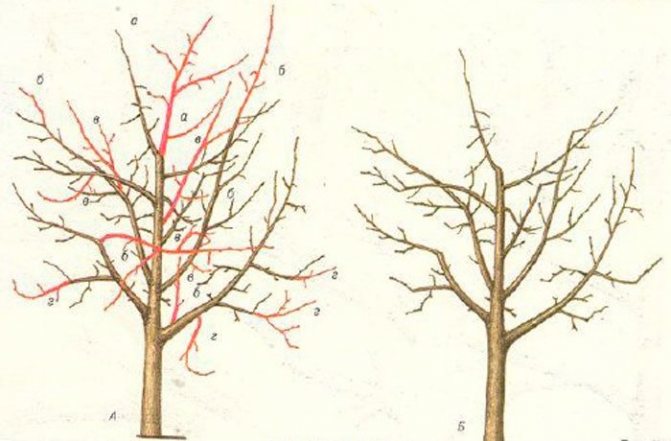

Mulberry pruning is recommended during partial or complete rest. The tree tolerates pruning best in early spring before sap flow begins. As a rule, rejuvenating and formative pruning is recommended from the last days of April to the first - May, before the kidneys open. In the autumn, when leaf fall ends, sanitary pruning is carried out, while the air temperature outside should not be less than minus 10 degrees.
How to prune mulberries
Different types of mulberry trees have different pruning characteristics. For example, the weeping mulberry needs thinning pruning, as well as pruning of stems and branches. Since this species is restored in a relatively short time, even very strong pruning is not afraid of it.
A stamped mulberry tree only needs to form a crown. To do this, on a long stem, on which branches are completely absent, you need to form a lush spherical cap or a falling cascade of branches.
The decorative mulberry is the most difficult to form. It will also be difficult to systematically maintain the original shape of the tree.
Mulberry pruning in spring
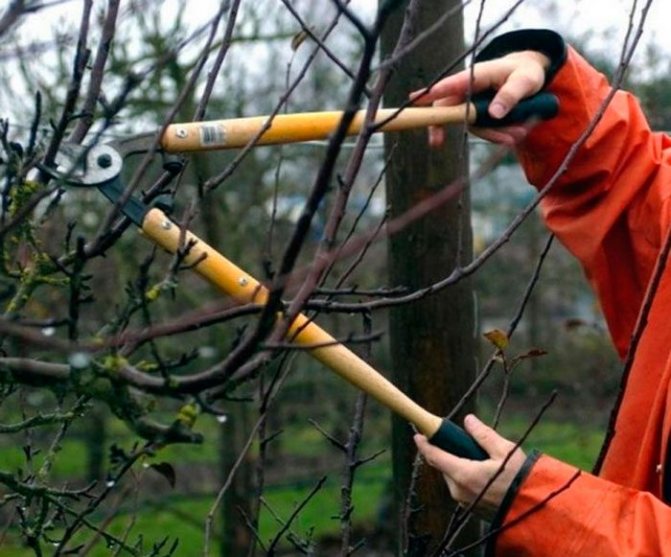

While the plant is young from its trunk to a height of 150 centimeters, it is necessary to cut off all branches. In this case, in an adult plant, the branches will not descend to the surface of the site. The preserved conductor can grow up to 5–6 meters by trimming all competing stems. If you don't want to do formative pruning, then just let the crown grow naturally. You can form a not very tall tree, which is convenient to care for. To do this, the apical shoot must be cut off at a height of 1.35–1.7 m, then a skeleton is formed, which should be similar to a dwarf apple tree. Such a tree should have 8 to 10 skeletal branches. When the plant is formed, you will need to maintain the created shape by cutting and plucking those stems that are not needed. It is not recommended to prune drooping branches; instead, they must be propped up.
Pruning mulberries in autumn
When all the foliage flies from the tree in the autumn, you need to start preparing it for wintering. So, at this time, it is necessary to make a mandatory sanitary pruning, for this you should cut out all injured, dried, damaged by frost or disease, excessively thin branches and stems, as well as those that grow inside the crown. As a rule, mulberry trees do not need annual sanitary pruning.
Low crown formation
Today, the formation of a decorative crown for a mulberry tree is becoming popular: spherical and falling. It is necessary to cut off all side shoots to a height of 0.5-1 m.This is best done in the spring, before bud break. The temperature must be at least -10 ° С. Then you can cut the crown, forming the shapes "ball", "broom" or "bowl" up to 4 m high.
It is difficult for beginners to immediately master the trimming technology. Invite a specialist and visualize the process. To maintain shape, trim the center shoot to a third or quarter length. Sanitary and rejuvenating pruning of branches is carried out every few years in late autumn.
Mulberry propagation
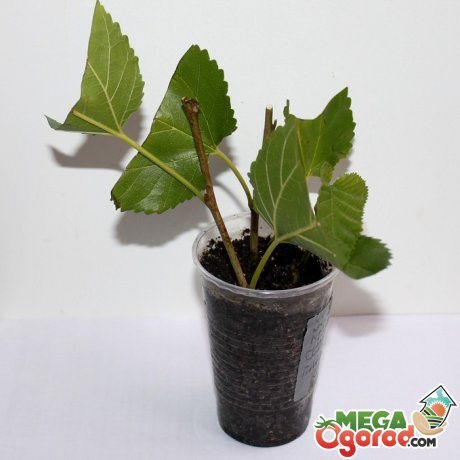

There are several ways to get a mulberry tree:
- Seeds previously stratified for 1.5 months in a cellar or refrigerator. You can sow them directly into the ground before winter.
- Root processes.
- Layers dug into the ground.
- Cuttings, preferably green, with 4-6 leaves. The lower ones are removed, the upper ones are cut in half. They are planted in a greenhouse under a film, after a month and a half they should take root. Lignified cuttings take root for a month longer. Before planting in the substrate, they must be treated with Kornevin. Seedlings are harder and stronger than cuttings. But parental properties are not always transmitted through seeds.
- By grafting one variety onto another. White mulberry is used as a stock. This method allows you to get the harvest much earlier. The specific features of the variety are preserved. Sometimes several varieties of different colors of leaves and fruits are grafted onto one stock.
Mulberry pests with photos and descriptions
Pests on mulberry rarely settle. Most often, this plant is harmed by American butterflies, Comstock worms, spider mites and mulberry moths.
White american butterfly
The greatest danger to the mulberry tree is the American white butterfly. The caterpillars of this pest are brown-green, with orange-yellow stripes on the sides and black warts on their surface. These caterpillars are able to gnaw all the foliage on the mulberry. Inspect the tree, cut and destroy the found spider nests. Special trapping belts must be installed on the trunk, and the crown of the plant must be sprayed with Chlorophos.
Mulberry moth
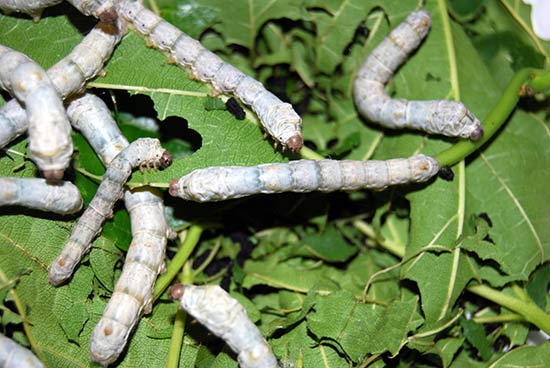

The caterpillars of the mulberry moth also feed on the foliage of this culture. To protect the plant from such pests, it should be treated with Chlorophos in the spring, when the buds are just beginning to swell, because it is at this time that such caterpillars appear.
Spider mites
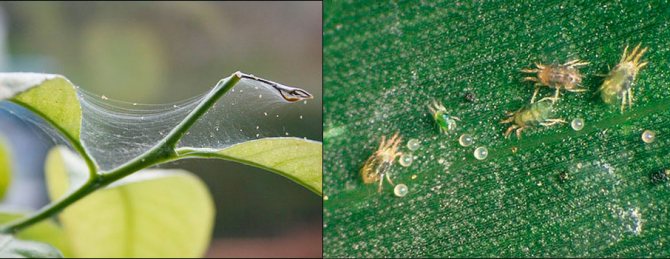

If spider mites settle on a tree, then the thinnest cobweb can be seen on it. The pests themselves are very small and cannot be seen with the naked eye. However, such mites pose a great danger to mulberries. Mites pierce the surface of the leaf plates and suck the juice out of them. As a result, the foliage becomes brown and flies around. You should also know that this pest is one of the main carriers of viral diseases that cannot be cured. A mite is an arachnid insect, therefore, to exterminate it, it is necessary to use acaricidal agents, for example: Actellik, Kleshchevit, etc.
Worm Comstock
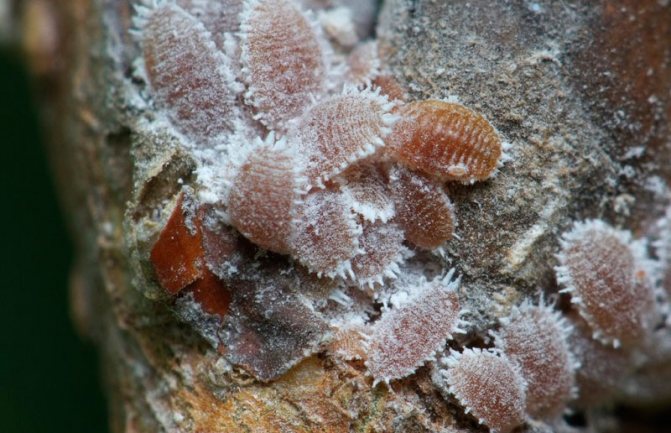

Another sucking insect is the Comstock worm. It settles on foliage, bark and branches of mulberry trees. The worm also feeds on the sap of the plant, as a result of which it is greatly weakened. Because of such a pest, tumors and wounds appear on the tree, deformation and drying of the branches occur, and the foliage turns yellow and flies around. To destroy the worms, the tree must be sprayed with pesticide.
Breeding history
The mulberry variety Black Baroness was bred in the twentieth century on the territory of the Soviet Union. Experienced breeders working at the Agricultural Academy named after V.I. K. Timiryazeva. To create this black mulberry, the varieties Black Prince and Pink Smolenskaya were used, which were naturally pollinated. Today it is included in the State Register and is actively grown throughout the country.
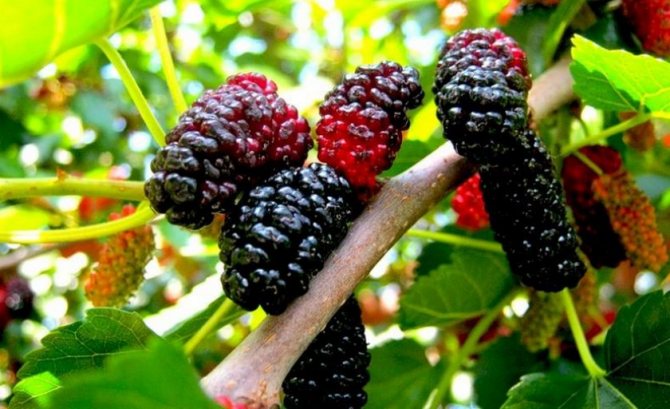

Advantages and disadvantages
- The main advantages of this type include:
- consistently high yield. Up to 90 kg of large berries are harvested from one tree;
- frost resistance. The plant experiences even a short-term cooling down to -30 ° С;
- adaptability to different climatic conditions of the region;
- monoecious, therefore, does not need additional pollinators;
- unpretentiousness in pruning, so a "weeping" shape can be made from a tree.
- Among the disadvantages of the Black Baroness variety are:
- Short shelf life (no more than 12 hours).
- Impossibility of transportation over long distances.
- Needs well-lit areas.
The appearance of the mulberry Black Baroness
The tree resembles a tent in shape. Its maximum height is 15 m. The crown is dense and round, which does not allow the sun's rays to accelerate the maturation of the culture. The bark is light, therefore the Black Baroness is often called the white mulberry. Spike-shaped inflorescences with white stamens.
Mulberry leaves are characterized by a wide-oval shape with a sharp top. A heart-shaped cutout can be seen at the base of the leaf, and teeth along the edges. The surface of the deciduous cover is glossy, dark green in color. Ripening dates are early. You can start harvesting berries in mid-June. Fruiting continues for a month.
The description of the berries is as follows:
- The color is dark purple.
- The shape is oblong, oval.
- Fruit length 3 cm.
- Weight up to 8 g.
- The taste is sweet.
- The pulp contains a large amount of juice.
- The aroma is pleasant, but not pronounced.
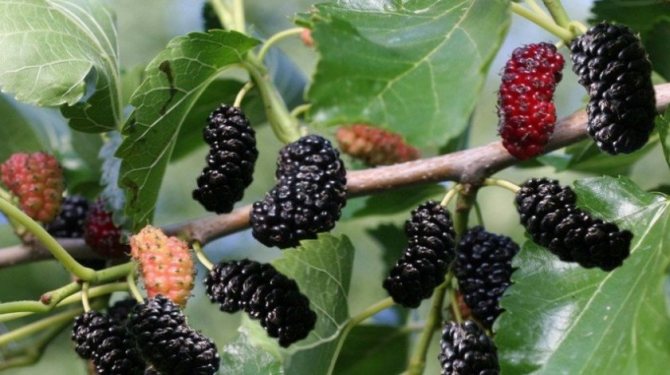

From the fruits of the Black Baroness mulberry variety, you can make delicious fruit drink, compote or jam. They are also ideal for making sweet dessert wines.
Mulberry diseases with photos and descriptions
The mulberry tree is distinguished by a fairly high resistance to various diseases, but in some cases it can also get sick. Most often he suffers from brown leaf spot (cylindrosporiasis), curly small leaves, powdery mildew and bacteriosis. The tree can also be damaged by the tinder fungus.
Powdery mildew
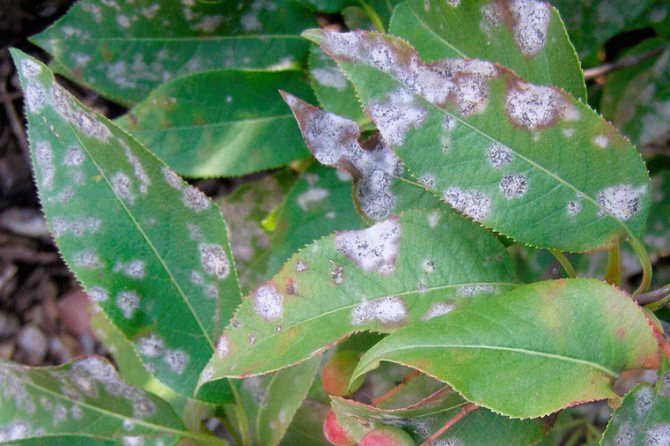

Powdery mildew is a fungal disease. In the affected plant, a whitish bloom forms on the surface of the stems and leaf plates. In the dry period, the disease develops most actively, especially if the crown of the plant is thickened. As soon as the first symptoms of the disease are found, the tree must be sprayed with Bordeaux mixture, Fundazol, or a suspension of colloidal sulfur. For the purpose of prevention, in the autumn, you need to rake and destroy all the foliage that has flown around.
Cylindrosporiasis
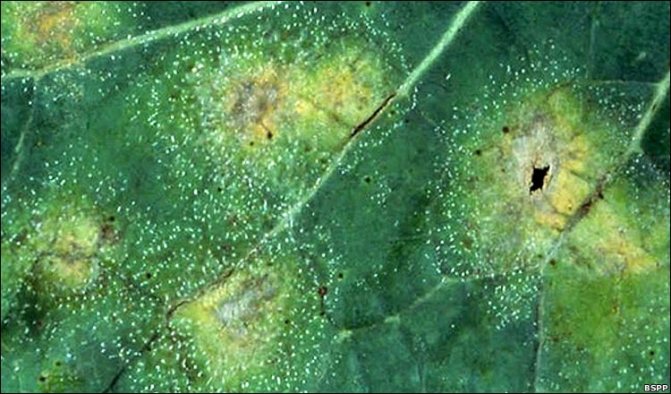

Brown leaf spot is also a fungal disease. In the affected specimen, spots of red-purple color are formed on the surface of the leaf plates, which have an annular border. As the disease progresses, the leaf tissue inside the specks spills out, the foliage itself turns yellow and flies around. As soon as the first signs of the disease are noticed, the tree should be treated with Silita solution (1%). In this case, about 3 liters of this solution should go to one plant. Re-processing is carried out half a month after the first.
Bacteriosis
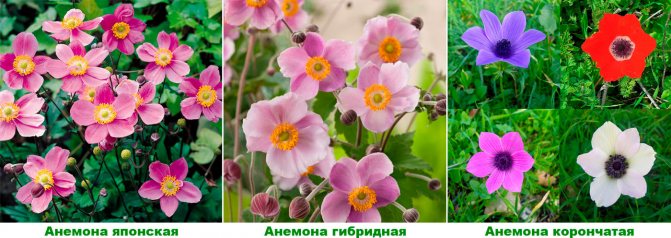

Most often, young stems and leaf plates of a mulberry tree are affected by bacteriosis. Irregular specks appear on their surface, over time they turn black. As a result of the development of the disease, twisting and flying around the foliage occurs, as well as deformation of the stems, while gum-like clots are formed on their surface. To combat this disease, the drug Gamair or Fitoflavin is used. However, it should be noted that it is not always possible to cure a plant with bacteriosis.In this case, you must try to prevent infection by regularly carrying out preventive treatments.
Small-leaved curl
Pests are carriers of such a viral disease as small-leaved curl. In a diseased tree, the foliage shrinks between the veins, and then grainy nodularity forms. As the disease progresses, the leaf plates shrink and fold, the stems become very fragile and rough, while an abnormal increase in their number is observed. This disease cannot be cured, which is why preventive measures are so important. To prevent the plant from becoming infected, it is necessary to fight insect vectors, these include all sucking pests, for example: thrips, aphids, ticks, etc.
Tinder
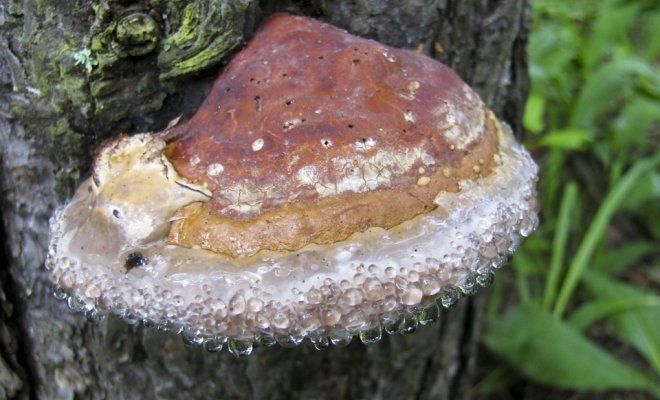

The tinder fungus settles on a tree and leads to the destruction of its wood. Its spores, getting into wounds and cracks in the bark, parasitize the plant, which leads to the destruction of its trunk. After such a mushroom is found, it must be cut out, capturing part of the wood, and destroyed. The resulting wound should be treated with a solution of copper sulfate (5%). Then it must be covered with a mixture, for the preparation of which you need to combine lime, clay and cow dung (1: 1: 2). If there are mechanical damages on the surface of the tree and gum flows out of them, then it is necessary to clean these wounds, then they are disinfected with a solution of copper sulfate (1%), and then they are treated with a solution consisting of Nigrol and wood ash, which needs to be sieved, are taken these components in a ratio of 7: 3.
Decorative varieties
Breeders have managed to breed some varieties as decorative varieties.
Decorative varieties of mulberry are used for the purpose of landscaping in park areas, in planting alleys, in city squares, in the creation of landscape designs. Representatives of decorative varieties are:
- White weeping mulberry. It can grow up to 5 m. Its long, thin branches fall down to the very ground and are very reminiscent of a willow.
- Another very unusual type of white mulberry is large-leaved. The name justifies itself, because the leaves of this variety can grow up to 22 cm.
- There is a dwarf remontant mulberry. This species was bred by selection. It can be successfully grown in a large pot.
- Golden. The shoots of this mulberry are yellow.
Black species
The homeland of the black mulberry tree is Iran. People have long appreciated the main and undoubted advantages of purple fruits. The taste of these berries turned out to be richer than white mulberries. In this magical tree of life, as it was called in ancient times, every organ is beautiful:
- mulberry juice purifies the blood;
- a decoction of young twigs helps with rheumatic pains;
- a decoction of the leaves lowers blood sugar;
- the roots remove phlegm with a strong cough;
- bark is an excellent remedy for worms;
- wood is used in furniture production.
The black mulberry tree has a dark brown bark, which explains the name.
As you know, fresh berries are stored for several hours. She does not tolerate transportation and long-term storage. You can get from it: juices, compotes, preserves, tinctures and even wine. In addition, the fruits have some healing properties: they can normalize metabolism, are effective for gastritis and gastrointestinal problems, and are useful for heart diseases. The juice is recommended for oral ulcers (such as stomatitis, tonsillitis).
Mulberry Black Prince
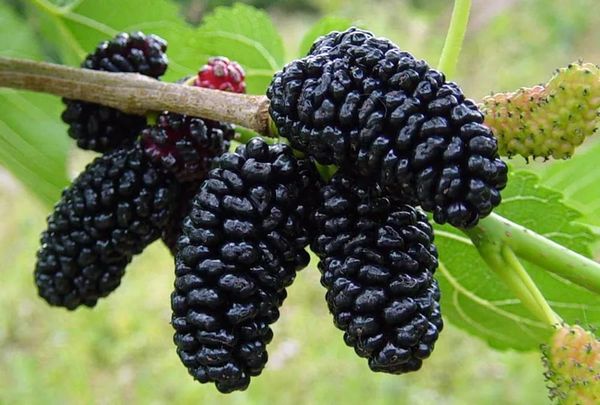

The black prince is a self-fertile, winter-hardy representative of the black mulberry. This is one of the few varieties that perfectly tolerates transportation and at the same time can be stored for a long time without compromising taste and quality. Its advantages are obvious:
- It does not require special care;
- easily tolerates both severe frosts and drought;
- pleasant honey taste;
- large and juicy black fruits;
- stored for a long time.
Ukrainian-6
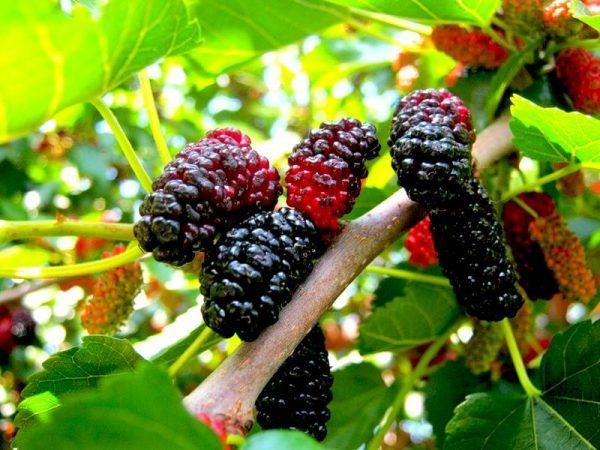

Another representative that keeps well and does not deteriorate during transportation. The tree has not only delicious fruits - it is also valued as a decorative one, it can serve as a kind of decoration for a garden plot.

